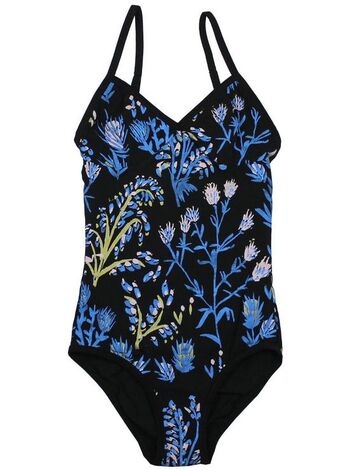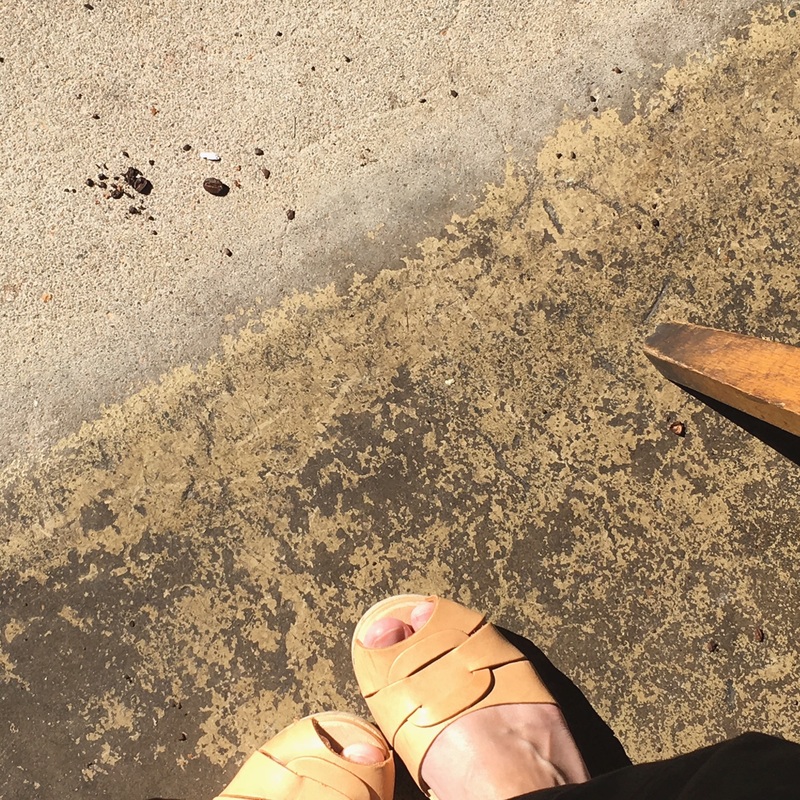|
Plastic bottles are being recycled into polyester, and nylon fishing nets are being recycled into econyl...which are being made into leggings + swimwear + fleece. Now we have closed- loop polyester...but is that even a good thing? In 2011, Marke Browne's paper "found that microfibers made up 85% of human debris on shorelines around the world" (which says a lot when shorelines can look like this). I wholeheartedly agree with Leah Messinger's 2016 assertion that "breaking a plastic bottle into millions of fibrous bits of plastic might prove to be worse than doing nothing at all." Why is it that almost an entire decade has gone by since these alarm bells were sounded + yet some of the most innovative "sustainable" brands are still messing around with plastic microfiber shedding product? And why are we still buying it? We're still buying it, because we've worn nylon swimwear our entire lives + we've been told that synthetic work-out wear breathes better than natural fibers. We like the performance + stretch that polyester provides. The thing is that climate change challenges our belief in the freedom of choice without consequence. Climate change will challenge our borders as climate refugees are forced to flee inhospitable conditions. Climate change will challenge us with the necessity of generosity + sacrifice for the sake of peace + the well-being of our fellow human beings. If we want to mitigate the speed + the level of climate change, we need to make some sacrifices now. I honestly have not found the switches I've made from polyester to natural fibers to be a terrible sacrifice in performance. It just involves an adjustment in expectations and, in some cases, a little bit of time to find an alternative. My cotton bottoms may sag a bit when I get out of the lake...oh well...I've left no plastic behind. :) Lycra + spandex are a major part of what make the current styles of swimwear + athletic wear possible. These synthetic elements are often added to even organic cotton pieces. Mixing fibers makes it harder to recycle cotton, + lycra/spandex will not biodegrade. We each have to wrestle with the impact of this knowledge. Is It possible to completely avoid lycra/spandex? Of course. We can simply choose to deal with the limits of purely natural fibers. We can choose to wear loose cotton shorts or pants to yoga class instead of leggings. I'm not going to completely leave lycra/spandex out of the discussion below. We might not choose to avoid lycra/spandex completely, but we can avoid as much as possible. Let's open ourselves up to the possibilities. Let's get creative. :) What can we wear instead of polyester + nylon? Warming layers :: Instead of fleece + capilene :: Sometimes advancements are wonderful + sometimes the old ways have good things to offer. Patagonia continues to embrace polyester fleece + capilene, but we've found merino wool to be soft, warm + water wicking. I'm excited to see that Ibex is returning this autumn. Duckworth + Ramblers Way make some wool pieces in the USA. Vegethreads designs + makes some lovely 100% merino wool pieces in Australia. WoolX, Smartwool + Icebreaker offer some 100% wool (be sure to check) pieces as well. All of these pieces hold up quite well, so look out for them on resale sites + in thrift stores. Obviously, one could just wear an extra cotton layer (like a sweatshirt) or an old cashmere sweater instead...why not? :) And keep them going by mending any holes that might appear over time. Swimwear :: instead of polyester, econyl or recycled polyester :: For someone like me, fairly made, organic cotton pieces like those from Pansy (available with natural rubber elastic + without added lycra/spandex), Arq or State work well for dipping toes into streams, wading in lakes or rivers + enjoying the sun. A cotton bodysuit like Nude Label's, Thief + Bandit's or Everlane's could work for some as well. Many of us only wear swimwear occasionally + a fewer of us really use it seriously for swimming or surfing. I thought that bamboo might be a good natural material for swimwear, but I was not able to find any at this point. There are some organic cotton/bamboo sports bras at Tasc that might be an option for some. This modal bodysuit from Commando (or this one from Ripple) is like bamboo in that it comes from natural origins, but requires more processing than other natural fibers. Apparently rayon fibers made up a large percentage of the fibers found in this study of microparticles found deep in the ocean. This provides us with further reason to avoid these fibers (rayon, lyocell, tencel). (Ugh.) Please don't be fooled by ChitoSante fabric made with shellfish shells. Only a small portion of the fabric is made up of (or treated with) this biomass. ChitoSante is polyester. Swimwear for serious swimming...at this point...may be an appropriate use of recycled polyester. These pieces of clothing are quite small + don't need to undergo rigorous agitation in the washing machine. If a wetsuit is in order, check out Patagonia's 85% natural rubber wetsuits. Continue to prod brands to seek innovation. Work-out clothing :: instead of polyester in all its forms ::
Tops: It's easy enough to wear an 100% cotton tee or tank already in our wardrobes instead of a polyester one. Sports bras: There are lots of organic cotton + hemp sports bras available. No reason not to embrace them (some brands below). Also consider the level of impact workouts entail. I find that for hiking, biking, walking, rowing, yoga + weights...I don't really need a heavy duty sports bra. Bottoms: Leggings aren't the only bottoms that can be worn for workouts. Consider looser bottoms that won't require such stretchy fabric. There are lots of organic cotton + hemp bottoms (including leggings). Conscious Clothing, Ripple Yoga, Ceres Sport, Hard Tail, Purusha, Reprise, Thief & Bandit, Satva, Tasc, Pansy + Pact are some great sources (check fabric content). I have done yoga in various Pact leggings which do hold up. Patagonia is investing in testing + technology meant to develop plastic fibers that shed less...but is that really any sort of solution? We already have access to the fibers that humans have been wearing for thousands of years...natural fibers that return to the soil. Processing these raw materials into clothing we can wear is not without cost to the environment, of course. The best thing we can do is to wear our natural fiber clothing over + over + over again...to mend + repair it...and to wash it as little as possible. There are gadgets + devices meant to attract or catch microplastic fibers before they can reach the drain, though the fibers must be discarded somehow...and some will inevitably fly off into the air or have to be tied up in a plastic bag to be preserved in a landfill for posterity. Keeping waste out of the landfill is always top of mind, and I'm really not sure what the answer is in regards to the polyester + nylon items we may be replacing. When I first replaced some of our jackets, I sold them thinking that that may keep those who bought them from buying new pieces. Maybe donating these pieces to be used in carpet underlayment would be positive? (We may have to cut an arm off in order to avoid resale + donate to Goodwill in a bag labelled "rags".) This processing will produce microfibers too though. The bottom line is: the less plastic microfiber producing items in production + use...the better. Our actions have an impact. Our voices may have a bigger impact. Educate + encourage with kindness. Encourage the people making these pieces to consider their impact + where they are spending their good intentions. Let's continue to ask for more innovation + creative thinking in this area. No more microfibers, please. Lovely photos via links. Unlinked photo, mine. A few more ideas: simple workout wear :: 3 ways. Love, Jane It's not quite sweatshirt season where we live yet, but I'm dreaming of it + thought this might be a good time to do a little fairdare favorites in this direction. There is so much to love about this trusty wardrobe staple. I love the comfort of sweatshirts + the way their washability allows them to really get worn + not to feel too precious. Sweatshirts in classic shapes can be happily worn for decades without going out of style. They are wonderfully without gender + present a great opportunity to share! (Personally I'm better at sharing his than sharing mine.) :) Many of us probably have a tried + true sweatshirt in our own wardrobes (or our partners') already. The fairest of them all is always the one we already have! It's possible to find great secondhand sweatshirts that have held up to years of wear + have been worn in just right. If the time comes to look for a new fair sweatshirt...there are a lot of great options out there, so it's hard to pick just a few as favorites. Here's what I'm looking for :: -shapes that I love + will want to wear for a long, long time -natural + organic fibers -natural, low-impact dyes -fair wages Aliya Wanek makes lovely sweatshirts. The shapes, the colors + the hemp/organic cotton fabric come together beautifully. These sweatshirts come in two silhouettes, are locally dyed + sewn in the Bay Area (San Francisco, California). My canyon Tig is one of my favorite pieces of clothing. The weight of the fabric is warm + the shape pairs well with pretty much everything in my closet. Rudy Jude made my other favorite sweatshirt. The fabric is a super soft, organic cotton sourced from a Japanese mill. Rudy Jude uses plant dyes that result in the most lovely colors which change each season. I chose the natural color, because I like it...and because a stain could easily be masked with a little indigo or madder dye in the future. :) These sweatshirts are dyed + sewn in small batches in Los Angeles, California. They are a bit pricey, but I was able to acquire my sweatshirt (the cropped style) on sale. Ijji sweatshirts are another favorite that falls (price-wise) in the same category as Aliya Wanek + Rudy Jude. These sweatshirts are made in Los Angeles from organic cotton grown in Texas + milled in North Carolina. At a much lower price point ($38), For Days makes sweatshirts out of organic cotton in Los Angeles, California. When a For Days sweatshirt wears out, it can be returned + recycled...and a new (30% recycled cotton) one can be purchased for $8! I tried on the Modern Crop + really liked its shape. It is a lighter weight than the other sweatshirts mentioned here.
Again, there are lots of options + price points out there! This is just a narrowing down of the longer list...for those with similar tastes + with no time to lose. :) Sweatshirt weather (to me) means getting outside to enjoy the sunshine + the breeze + all that the day has to offer! Get it! All lovely, linked photos via links. Unlinked photos, mine. More fairdare favorites...right this way! Love, Jane Ottowin footwear are handmade in Bristol, UK by a passionate pair of makers. Lovely sandals, shoes + boots for women, men + babes are made to stand the test of time. Each pair is made by hand once an order is placed. Materials are locally sourced + scraps are made into wallets + baby shoes. Sandal, shoe + boot making workshops are offered at their shop. This peek into the Ottowin process is a great reminder that every pair of shoes is made at least partly by someone's hands.
Love, Jane Fleece, swimsuits + leggings made from some amount of recycled plastic are commonly touted as sustainable or ethical fashion...even as microplastic particles shedding from these items of clothing in the wash have been found the water we drink, the fish that we consume, the air we breathe + even in rain. As many as 10-12 million plastic microfibers can be released in a single load of laundry!
Recently a "sustainable" fashion brand announced that they would be taking back spent recycled plastic leggings in anticipation of closing the loop + making new leggings out of the discarded ones. We're in confusing times when terms like closed-loop induce initial jubilation...but further thought brings skepticism about the proliferation of plastic particles. Surely it is a good thing to recycle plastic bottles into something useful...isn't it? Surely it is a good thing to recycle these discarded objects into new useful items...isn't it? But if this process produces harmful substances along with the useful objects (+ promises to continue producing these harmful substances with each use), is that actually a positive advancement? Circular polyester will shed billions + billions of microfibers in its manufacture + use. Can we really tout so-called closed-loop polyester as an ethical or sustainable advancement? I have to say that I admire a number of brands that have been pursuing this technology in so many ways. They have done the work of obtaining fair labor for the manufacture of their pieces. They have chosen to use recycled materials. When microplastics became headlines, they started selling devices + even washing machine attachments that collect the fibers. They funded research into lesser shedding polyester + closed-loop polyester technology. Sadly, I wonder if washing machine attachments + closed-loop technology is time + energy spent in the wrong direction. Wouldn't it be better to address plastic bottle usage + nylon fishing net dumping + the general overuse of plastic? Wouldn't it be better to work toward making natural fibers more suitable for use as leggings + swimwear + warming layers? Let's be thoughtful about so called sustainable advancements + products. Let's put our dollars + efforts toward real solutions. For some alternatives to microplastic shedding clothing, right this way! Love, Jane Writing in this space most often brings me around to the most positive parts of the fairdare. There are so many: compassion for garment workers, farmers + ourselves, less, enough, gratitude, simplicity, less impact on the environment + so many more. At the same time, I try not to sugarcoat my own efforts to wear what is already in my closet, to mend + repair in order to prolong wear, to thrift, make + only as a last resort to purchase fairly made clothing. This challenge has gotten easier in many ways...but still offers some level of difficulty for me.
Long story short...this summer was a struggle in the wardrobe department. Whether I was wrestling with... -my relationship with my body or age or -the feeling that nothing is novel or -a lack of clarity on what I want to wear + think I look good in or -the lack of access to good local thrifted/fair pieces that I can try on or -the expectations I have for each + every piece in my wardrobe (style, comfort, desire to wear over + over again) or -perpetually second guessing myself ...I'm guessing that I'm not completely alone. Wishing I had just stayed focused on this plan...and not second guessed myself repeatedly. Anyway...I want to offer myself more kindness + love going forward. I hope you will do the same. Love, Jane |
on a journey toward zero-waste, simplicity, + compassion :: daring to choose fair one choice at a time
|























 RSS Feed
RSS Feed